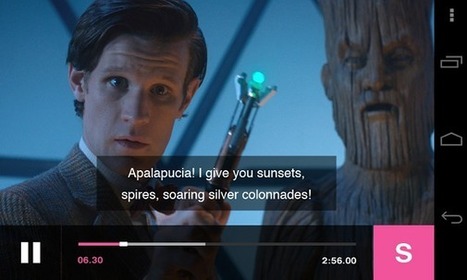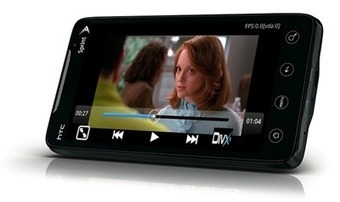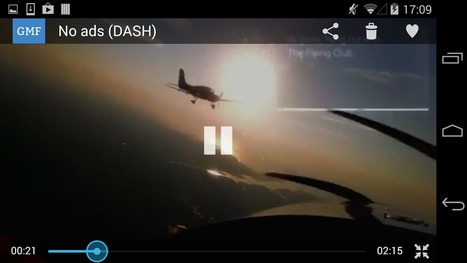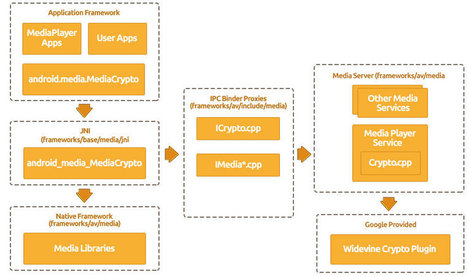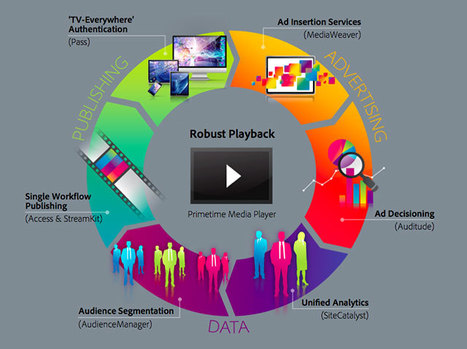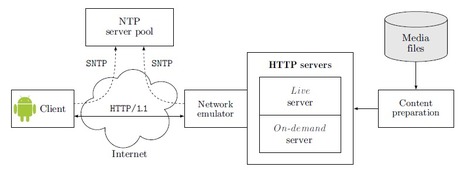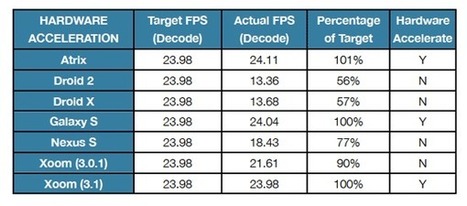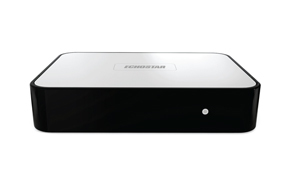 Your new post is loading...
 Your new post is loading...

|
Scooped by
Nicolas Weil
November 9, 2014 5:18 PM
|
Ittiam Systems is pleased to announce its bringing the power and scale benefits of the advanced High Efficiency Video Coding (HEVC / H.265) technology to the mass market. Ittiam worked over the last several months to bring native HEVC Decode to Android, by way of the standard’s inclusion in the Android Media Framework, within Android 5.0, Lollipop.

|
Scooped by
Nicolas Weil
January 17, 2014 12:39 AM
|
By way of background, Android’s initial streaming strategy centered around the Flash player, which worked acceptably well until Adobe pulled the plug on updating the Flash player for Android and other platforms. This left Google in the lurch, which it tried to fill by adding support for HTTP Live Streaming (HLS), starting officially with Android 3.0+. This approach, implemented well, would be very attractive to producers who are already serving HLS streams to iOS devices, which support HLS natively.

|
Scooped by
Nicolas Weil
January 1, 2014 9:08 AM
|
One question I often receive is regarding HTML5 video on Android. It often causes confusion, since the term “HTML5 video” doesn’t define the supported feature set, especially when it comes to advanced streaming features, such as streaming protocols, closed captioning or content protection. The short summary is that Android does not match the iOS HTML5 streaming capabilities, which leads to unpleasant surprises when opening an iOS optimized video streaming site in the Android browser. But why is this the case when Android is leading with an 80% market share? To better understand the challenges today, let’s look at the history of browser based video on Android.

|
Scooped by
Nicolas Weil
April 11, 2013 6:39 PM
|
Just in time for NAB, VisualOn and Discretix are announcing the release of SecurePlayer 2.0, which provides publishers with iOS and Android playback protected with Microsoft PlayReady DRM (digital rights management). The player works with MPEG-DASH, HLS, and Smooth Streaming content. SecurePlayer 2.0 combines VisualOn's OnStream MediaPlayer+ with Discretix's DRM security.

|
Scooped by
Nicolas Weil
December 22, 2012 6:06 AM
|
Unlike Apple's iOS platform, Google has yet to provide an easy way to get live video to Android devices. Worse yet, it hasn't offered a strategy for fixing the situation. Many content owners who want to get their live event-based streaming content on mobile phones and tablets quickly find out that getting it to Android devices is extremely challenging. Unlike Apple’s iOS platform, Google has yet to provide an easy way to get live video to Android devices, and to date, it hasn’t detailed any strategy for fixing the situation. Many content owners I have spoken with, as well as those who help these content owners encode and distribute their video, are now questioning why they should even continue to go through all the trouble of trying to support Android-based devices at all.

|
Scooped by
Nicolas Weil
November 7, 2012 7:19 AM
|
Fraunhofer IIS, the world’s renowned source for audio and multimedia technologies and BuyDRM, the premiere provider of multiscreen media technologies collaborated with HBO Europe's HBO GO broadband SVOD service to showcase the full potential of the new MPEG-DASH ISO standard. As part of the showcase viewers experienced scenes from HBO’s Boardwalk Empire via an Android phone utilizing built-in AAC surround sound technology from Fraunhofer using BuyDRM’s secure video playback client. In combination with MPEG DASH, Android devices become true and trusted consumer platforms allowing HBO Europe to easily offer content in the most efficient, highest-quality way using the AAC Multichannel solution from Fraunhofer. Subscribers to HBO GO on Android can benefit from foolproof surround sound delivered as easy and convenient as watching a BluRay or DVD. Using a variety of KeyOS technologies, BuyDRM’s MPEG-DASH client implementation provides stutter-free streaming as network conditions change. BuyDRM integrated MPEG-DASH support and Microsoft’s PlayReady DRM in the showcase using MPEG video and audio codecs that ship natively with the new Android 4.1 operating system.

|
Scooped by
Nicolas Weil
September 21, 2012 6:45 AM
|
As many of you are aware, we chose Adobe Flash as the media format to stream to Android devices. Doing so provided us with a number of cross platform efficiencies as the same infrastructure can be used for delivery on PCs, Android phones, and set-top boxes. Adobe's strategic decision to remove support for the Flash Player plug-in meant that we had to change the way that we play back this content. [...] We looked at a number of different solutions, for example, Http Live Streaming (HLS) which is used to stream BBC media to other platforms. Unfortunately, HLS isn't supported on Android OS versions prior to Honeycomb. In the end, Flash was still the best choice of media format for us to use. And the only practical technology for us to play this format back on Android is Adobe Air.

|
Scooped by
Nicolas Weil
May 22, 2012 7:10 PM
|
Multimedia is one of the most important component in the mobile devices. The main goal of this project is to add the new "streaming standard" into Android multimedia framework allowing adaptation using also full-HD sequences. Natively Android framework is already able to support video streaming using Apple HLS standard. The idea is to extend the handler adding all the logic to manage playlists not only in m3u8 format but also as MPD file (Media Presentation Description). Also the work enrich the multimedia framework of a new component to add a basic set of adaptation heuristics acts to adapt dynamically the streaming bit-rate in use accordingly to some basic platform information like screen resolution and average system throughput.

|
Scooped by
Nicolas Weil
January 26, 2012 5:35 AM
|
Octoshape and Crunchfish announced today a partnership that integrates Octoshape Infinite HD technologies into Crunchfish mobile application development platforms. The combination of Crunchfish's unique mobile app design and Octoshape's high quality and efficient global content distribution technology sets the stage for rapid monetization of broadcast quality content on all connected devices. The first apps for iPhone, iPad and Android were showcased at CES in Las Vegas this year.

|
Scooped by
Nicolas Weil
December 5, 2011 4:13 PM
|
The popularity of mobile devices is pushing most of online video projects to adapt their services to mobile applications (e.g., tablets or smart phones). In the context of many online video services needing video content protection (for example, to offer content libraries from the major Western movie studios), implementing of DRM features in a mobile video player is becoming a critical task. As always, you have a set of solutions and platforms to choose from. Recently, we wrote of DRM features in iOS. Now, it’s high time to talk about Android DRM.
|

|
Scooped by
Nicolas Weil
August 17, 2014 6:16 AM
|
We’re excited to announce an open source video player framework to make online video and video monetization with the IMA SDK easier than ever. The Google Media Framework (GMF) is available for iOS and Android, and we have a Video.js plugin for web based video players.
MF Features - Ready to use Video player for your apps and websites
- Demo apps include production ready integrations with the IMA ads SDK
- GMF is free and open source, so can be customized to meet your specific needs (Send us a pull request!)
- Easily customize the UI color and add or remove buttons
- Support for iOS 7+ and Android 4.1+

|
Scooped by
Nicolas Weil
January 14, 2014 6:44 PM
|

|
Scooped by
Nicolas Weil
July 30, 2013 5:01 PM
|
Android has limited support for HLS (Apple’s HTTP Live streaming protocol), and device support is not the same from one version or one device to the next. Android devices before 4.x (Gingerbread or Honeycomb), do not support HLS. Android tried to support HLS with Android 3.0, but excessive buffering often caused streams to crash. Devices running Android 4.x and above will support HLS, but there are still inconsistencies and problems.

|
Scooped by
Nicolas Weil
January 11, 2013 6:16 AM
|
Just in case anyone was in doubt that the 4K revolution is happening, Nvidia has just announced that its much anticipated Tegra 4 mobile chipset will include "4K Ultra-High-Def video support"
The Tegra 4 is significant because it has six times the GPU horsepower of the Tegra 3, and also incorporates ARM's most advanced CPU core, the Cortex A15. Just a few days ago, we predicted that ARM was going to be a technology to watch this year. The new chipset will obviously be used in mobile platforms, from phones to tablets, and quite possibly games controllers and consoles, and the raw video processing power is unmatched in what is already a feverishly active area for technical innovation.

|
Scooped by
Nicolas Weil
November 15, 2012 6:50 AM
|

|
Scooped by
Nicolas Weil
October 26, 2012 6:43 AM
|
Helix v15 offers DASH support for both live and on-demand profiles. More interestingly, it will also offer support for both ISO Base Media File Format (ISO BMFF, or fragmented MP4) as well as MPEG-2 Transport Streams (M2TS). The Helix Client SDK for Android can be used in Android applications to create an end-to-end delivery solution that includes the Helix server and a client app. Interestingly, the Helix SDK can be used to deliver HLS content to Android OS 2.2 and higher. Google has added integral support for HLS in Android OS version 3 or higher, but has not addressed the larger addressable market of pre Android OS 3.0 devices. Finally, Helix has digital rights management (DRM) support for a number of device types, including devices based on several key operating systems: Android, iOS, Mac, and Windows. Real's DRM leans heavily on Verimatrix's DRM solutions, using Verimatrix VCAS for HLS devices—via the ViewRight plug-in—as well as the ViewRight Client on PCs and set-top box devices. In addition, Real says that PlayReady support should be available in an upcoming dot release. HELIX SDK for Android : http://www.realnetworks.com/helix/helix-sdk.aspx

|
Scooped by
Nicolas Weil
May 24, 2012 9:58 AM
|
Thesis : A Dynamic Adaptive HTTP Streaming Video Service for Google Android (HLS/DASH)
ABSTRACT OF LUCIANO ROMERO'S THESIS : Adaptive streaming approaches overHypertext Transfer Protocol (HTTP), such as Apple’sHTTP Live streaming (HLS) andMicrosoft’s Live Smooth Streaming, have recently become very popular. This master’s thesis project developed and evaluated several media rate adaptation algorithms optimized for mobile networks with a client running on Google’s Android operating system. The deployed service supports HLS and the emerging ISO/IEC MPEG standard called Dynamic Adaptive Streaming over HTTP (MPEG-DASH).
Live media was the focus of the evaluation, since this content can not be cached in advance at the user’s device, hence the quality of the user’s experience will be affected by the currently available bandwidth which the user can utilize. Experiments were performed for multiple scenarios illustrating different network capabilities, especially various amounts of bandwidth available to the user.
This project has produced an implementation of HTTP-based adaptive streaming. This implementation follows the MPEG standard and enables robust and smooth playback of live video content via Google’s Android devices. Results of the experiments have shown that the proposed adaptation mechanisms efficiently utilize the available bandwidth of the network. A
clear conclusion of this thesis is that adaptive streaming will in fact enable substantial numbers of users to enjoy live media streaming to their devices. READ THESIS HERE : http://web.it.kth.se/~maguire/DEGREE-PROJECT-REPORTS/111006-Luciano-Rubio-with-cover.pdf

|
Scooped by
Nicolas Weil
February 16, 2012 1:06 AM
|
What Did We Do? We performed live streaming delivery tests, using RTMP and RTSP streaming protocols from a streaming server. We chose to use Flash Player for RTMP playback and the native Video app (an underlying player on most Android devices, not to be confused with the YouTube app) for RTSP streaming playback.
So What Did we Find? In our tests, several patterns emerged. First, on the performance front, content delivered in RTMP (the Flash Player "native" protocol) was consistently delivered at a higher frame rate than content delivered by RTSP to the native Video app, even when both were served from the same Wowza Media Server. None of the delivery solutions were perfect, by any means. Content played back as RTMP, RTSP and even HTTP dropped some number of frames for every clip played. That's to be expected in a mobile environment, and as mentioned above, our test clips were intentionally robust enough to tax the devices. Yet we were surprised to find that-although the content was streaming out from the server at full frame rates and resolutions-several devices just couldn't muster the performance necessary to play back content with the native video app and RTSP protocol.

|
Scooped by
Nicolas Weil
January 26, 2012 4:24 AM
|
A Streaming Media West panel offered tips on coping with the fractured landscape of handheld hardware. Once, preparing video for the Web meant choosing the format that would reach the greatest number of viewers. Now, the landscape has become much more complex. For one thing, even small businesses that serve video need to think about reaching viewers on tablets and other mobile devices. How to do that was the topic of a panel discussion at the recent Streaming Media West conference in Los Angele

|
Scooped by
Nicolas Weil
October 6, 2011 3:31 PM
|
Android set-top boxes provide a simple and cost-effective way to make popular apps that consumers are used to seeing on tablets and mobiles available on TV. At IBC2011, EchoStar Europe was demonstrating how the Angry Birds game and the IMDb (Internet Movie Database) can be incorporated into a digital TV service, while at the same time demonstrating how a new generation of pure IP set-top boxes, including a Blackberry smartphone sized device, can be used as thin clients in a multi-room architecture. The HDX-200 shown at IBC was a demonstration platform; the product will be commercialised within the next year. The Android operating system is only one ‘middleware’ option for this device but clearly an interesting one. Android is effectively the middleware, sitting on top of Linux. Mark Goodburn, Director of Marketing and Communications at EchoStar Europe, pointed out that applications developed for the mobile and tablet market can now be made available for the TV without having to rewrite them. And he added: “Some operators have their own applications and are delivering those to smart TVs already, and they also want to deliver them to set-top boxes.”
|
 Your new post is loading...
Your new post is loading...
 Your new post is loading...
Your new post is loading...










![Fraunhofer IIS and BuyDRM Demonstrate First-Ever Surround Sound Player for Android Phone with MPEG-DASH and PlayReady [PR] | Video Breakthroughs | Scoop.it](https://img.scoop.it/XstKs1HSBveYn4cev7TW7Tl72eJkfbmt4t8yenImKBVvK0kTmF0xjctABnaLJIm9)
